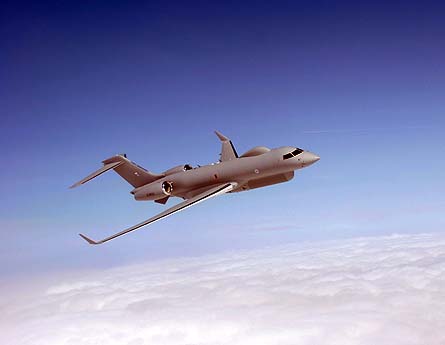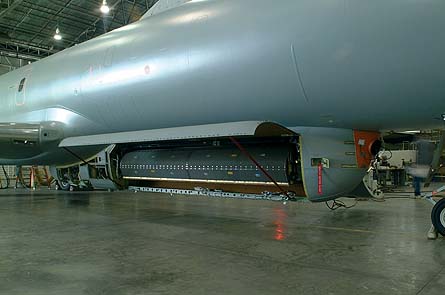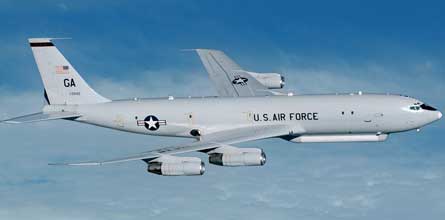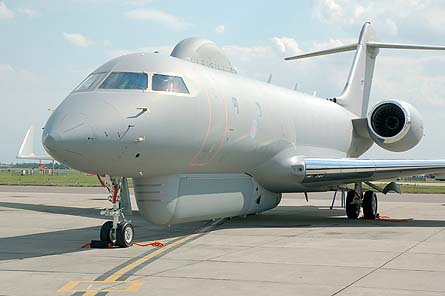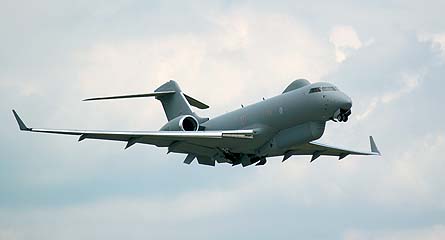By Craig Hoyle at RAF Waddington
This year’s Farnborough air show will provide the first opportunity for many in the aerospace community to see the UK’s next-generation military surveillance aircraft, with the debut of the business jet-based Sentinel R1. A near-term addition to the Royal Air Force’s secretive fleet of intelligence, surveillance, target acquisition and reconnaissance (ISTAR) aircraft, the Sentinel will provide the core capability for the Airborne Stand-off Radar (ASTOR) system – a UK equivalent of the US Air Force’s Northrop Grumman E-8C JSTARS airborne ground surveillance system.
|
|---|
| The UK's Sentinel R1 will make its first major public appearance at Farnborough |
The Sentinel on static display at Farnborough is the third of five modified Bombardier Global Express aircraft that will form the backbone of the ASTOR system being delivered by UK prime contractor Raytheon Systems (RSL). Selected in 1999 to meet the UK’s battlefield reconnaissance requirements from late this decade, the Sentinel made its first public appearance late last month during an air show at its future home, RAF Waddington in Lincolnshire.
Aircraft XJ692 is expected to arrive at Farnborough with a new addition: its active-array synthetic-aperture radar/ground moving-target indication (SAR/GMTI) sensor, installed at RSL’s Broughton plant in north Wales. Once operational, this will provide mission commanders with high-resolution imagery of an area of operations, including details of vehicle movements, by day or night, largely unaffected the weather.
Reflecting the generational difference between ASTOR and JSTARS, which entered service in the early 1990s, the UK aircraft are considerably smaller than the USAF’s Boeing 707-based platform, and are configured to carry a crew of just five: two pilots, two image analysts and an airborne mission commander responsible for the planning and execution of surveillance tasks. The Sentinel can be easily distinguished from the baseline Global Express by the new radomes that accommodate its dual-mode radar and satellite communications equipment. More subtle modifications include the addition of ventral fins beneath the rear fuselage and a 380mm (15in) increase in fin height to improve lateral stability.
Sentinel’s appearance at Farnborough will come as a welcome boost to the UK ISTAR community, which is marking the retirement from operational service of the RAF’s last few English Electric Canberra PR9 photographic reconnaissance aircraft, and is also awaiting production approval for BAE Systems’ Nimrod MRA4 maritime reconnaissance and attack aircraft.
To meet the in-service date (ISD) target of November 2006, two aircraft must be available with two tactical ground stations, support services and sufficient trained personnel. In an exclusive interview with Flight International at RAF Waddington last month, Wg Cdr Bill Hughes, officer commanding the service’s 5 (Army Cooperation) Sqn, said: “We are striving to achieve the milestone goal of November 2006, but there is still much complex work to be done.” The squadron and the UK Defence Procurement Agency are confident, however, that ISD will be declared no later than March 2007.
Customer caution appears to be at odds with industry optimism, however, with Raytheon Space & Airborne Systems’ vice-president integrated airborne systems Tom Kennedy saying: “Raytheon has put additional focus on the work and is committed to meeting that November ISD.”
Joint-service team
Hughes says 5 Sqn expects to take delivery of its first Sentinel from RSL “within the next three to eight months”, and all five aircraft and eight ground stations will be at Waddington by mid-2007. Training and software proving work is already ramping up at Waddington. The squadron has around 130 of the 300 personnel it will need: at full strength 160 will come from the RAF and 140 from the British Army. In a new move intended to boost its joint-service composition, the unit may also include around five Royal Navy personnel. The first two of these – ground image analysts – are expected to join later this year. Additional posts could include airborne mission commanders and aircraft engineers.
|
|---|
| The Sentinal's dual-mode radar is at the heart of the ASTOR system. In SAR mode, the radar provides high-quality battlefield imagery |
“The joint service structure has been interlaced deliberately all the way down,” says Hughes, who notes that each of the squadron’s eight aircrews will comprise two RAF pilots, one image analyst from the air force, one from the army and, in most cases, an air force mission commander. Similarly, in the ASTOR system’s eight vehicle- and ISO container-housed stations, image exploitation work will be carried out by a mix of personnel from the air force and army intelligence communities.
A sixth crew member could be carried on the aircraft under certain mission scenarios, such as operation with no or minimal ground station elements. Eventually, 5 Sqn plans to have four air collection managers available to provide an interface between the aircraft and the ground commander and to arbitrate between any conflicting mission priorities.
|
|---|
| In service since the early 1990s, the USAF's JSTARS fleet relies on Boeing's venerable 707 airframe |
Operating concepts for the Sentinel comprise on-tether missions, with forward-deployed ground stations, and off-tether missions without ground support. In the early days of the 2001 Afghanistan conflict, for example, a Sentinel operating off-tether could have provided vital battlespace imagery by conducting on-board analysis before sending data back to the squadron headquarters at Waddington using a global satellite communications capability. If operationally available today, the aircraft would be called on primarily to perform GMTI tasks, for example surveillance of vehicle movements along porous borders in theatres such as Afghanistan and Iraq. “The aircraft does have significant utility without any ground station footprint,” says Hughes. “There will be a very significant thirst for its output.”
|
|---|
However, it is in the on-tether and coalition scenarios where ASTOR’s image-gathering capabilities, effected in concert with other UK and coalition ISTAR assets, will be of greatest use to operational commanders. The system’s ground exploitation stations can also receive imagery from the Goodrich DB-110 camera carried by the RAF’s Raptor pod-equipped Panavia Tornado GR4s and from the ground station for the British Army’s future Watchkeeper 450 tactical unmanned air vehicle system.
Network enabled
The system’s modular ground stations and communications vehicles are all based on a Pinzgauer chassis and can be transported by Lockheed Martin C-130Js. The vehicles are equipped with the same workstations used by the image analysts on board the aircraft. As part of the UK’s planned network-enabled capability, the ASTOR system will work with ground battlefield communication links such as the Bowman, Cormorant and Ptarmigan radio systems.
The ASTOR system’s ground element has already demonstrated its ability to receive radar imagery and secure voice communications from JSTARS aircraft and, under a new contract between the UK Ministry of Defence and Raytheon, operators aboard the Sentinel will also be able to receive images directly from USAF aircraft via datalink, a capability already demonstrated for the UK, says Kennedy.
While the Global Express’s maximum altitude and speed performance has been slightly degraded by the UK-specific design changes implemented to produce the Sentinel, Hughes says the aircraft will still be capable of flying significantly higher than 40,000ft (12,200m] – against a 51,000ft maximum for the Global Express – and of delivering an unrefuelled mission endurance of over 11h.
The elimination of an earlier requirement to modify the Global Express airframe to carry an in-flight refuelling probe removed 50% of the programme risk at that time, according to the RAF. Cruise speed at altitude will be maintained at between Mach 0.74 and M0.87 and the aircraft has a ferry range of over 9,250km (5,000nm). Flight-control software changes introduced to compensate for the airframe modifications mean that “if one of our pilots flew the Sentinel or the Global Express he wouldn’t know the difference,” says 5 Sqn chief pilot Sqn Ldr Tony Flynn.
Bombardier’s standard Global Express cockpit has been retained to reduce programme costs and capitalise future software modifications to the commercial model. The new military application has, however, required the addition of a communications panel to manage the aircraft’s two V/UHF radios and UHF satcom suite, all of which can be operated in secure mode.
The ASTOR cockpit also features a new centrally housed, pull-down screen that can display a moving map, Link 16 datalink information and defensive aids subsystem (DASS) data. Common with the system installed on the RAF’s developmental Nimrod MRA4, the DASS comprises a towed radar decoy, missile approach warning system and chaff and flare dispensers and can be operated in automatic, semi-automatic or manual mode.
Detailed engineering flight tests of the Sentinel continue at Raytheon’s Greenville site in Texas, with two aircraft undergoing extensive scrutiny until late last month. “We have completed all the flights to determine that the radar works and are now into detailed engineering flight tests,” says Kennedy. “We believe we are meeting the radar performance, but we have to prove it from all different angles, altitudes and ranges.” GMTI performance data has recently been presented to the UK MoD for approval, he says, while the programme’s remaining two radars have already completed qualification testing.
|
|---|
| The Sentinel made its public debut at last month's Waddington air show |
In addition to gathering data on the performance of the aircraft’s SAR/GMTI sensor, each of the approximately 6h test flights conducted since September 2005 has been used to assess the early performance of other system elements, such as communications and DASS equipment, and to conduct electromagnetic interference and compatibility testing. However, programme sources concede that the length of time needed to analyse radar data thoroughly since the first data-gathering flight in late October has been a frustration and contributed to a decision to expand the flight-test fleet at Greenville to two aircraft and to use a third radar in a laboratory to speed proving work (Flight International, 17-23 January).
Conversion sorties
Six of 5 Sqn’s pilots have so far completed initial training on the Global Express at Bombardier’s Montreal site, obtaining civilian type ratings over a three-week period on the aircraft. They subsequently underwent ground-school training at Waddington before conducting two or three conversion-to-type sorties and operating as a full aircrew for the first time. Currency is being retained using Sentinel aircraft still in modification at RSL’s Broughton site and by conducting refresher training in Canada every six months using Bombardier’s full-flight simulator. The first pilots will be approved as combat-ready after a further six months of training, says Hughes. Plans to train a total of eight aircrews will leave 5 Sqn’s manning levels slightly below the RAF’s typical ISTAR crewing ratio of two crews per aircraft.
Refresher training will be launched for 5 Sqn crews later this month to enable them to use the latest standard software load. Basic training for the RAF’s newly established 54 Sqn operational conversion unit will start in 2008. This will manage training for the Sentinel, plus the Boeing E-3D Sentry airborne warning and control system and British Aerospace Nimrod R1 electronic intelligence aircraft also based at Waddington. An operational evaluation unit will then establish the baseline capabilities of the ASTOR system and inform 5 Sqn of its initial operational capabilities. This assessment, conducted in the UK using the programme’s first production aircraft, will comprise around nine sorties and test the radar’s performance and accuracy against a set of “ground truth” vehicles on Salisbury Plain.
The 5 Sqn footprint at RAF Waddington includes a hangar with room to accommodate four Sentinel aircraft, half a hangar for ground vehicles and a training school owned and managed by RSL. The operational training system, now in the final stages of acceptance, includes what squadron personnel refer to as “an ASTOR in a box” – a procedural flightdeck trainer and rear and ground operator stations that can be linked together. “This means we can fight the entire ASTOR system in one room,” says Hughes.
Initial operating capability – the point at which ASTOR is officially ready to be deployed – is expected within 15 months of the in-service declaration, with four crews combat-ready and equipment levels boosted by the delivery of one operational-level ground station. Within a further 12 months – around early 2009 – the system will be declared fully operational, with all eight crews combat-ready, four aircraft available at any one time and a full complement of six tactical and two operational-level ground stations in use.
Looking to the future, the addition of Raytheon’s MTS-B electro-optical/infrared sensor has already been outlined to the UK as a potential upgrade path, and this could draw on the company’s efforts to promote the Sentinel airframe as the basis for the US Army’s stalled Aerial Common Sensor platform.
The DPA says there is a limited scope to conduct further modifications to the Sentinel, but that the aircraft’s zero fuel weight is “a particular limitation that will need to be addressed” if an RAF aspiration to carry more than seven personnel is to be realised. “We are actively looking, with Raytheon, to increase the maximum zero fuel weight beyond the current limit as part of the future capability roadmap,” says integrated project team leader Bill Chrispin. “For now we are focusing on getting the ASTOR system into the hands of the UK armed forces.”
Source: Flight International

















